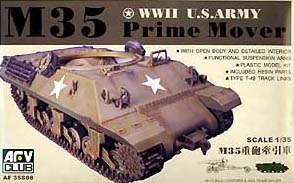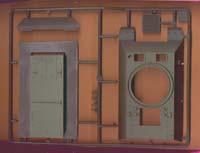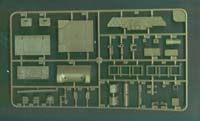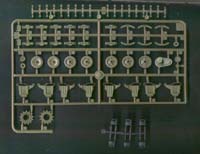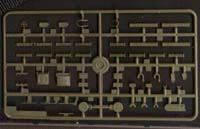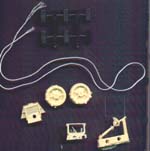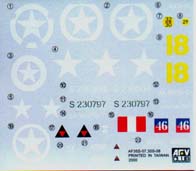A.F.V. CLUB 1/35 M35 WWII U.S. ARMY PRIME MOVER MSRP: $36.98 | | Introduction
Battles were being mostly fought on Italian soil in 1943. The Allies
considered Italy as a secondary battlefront with two objectives: 1. To
force Italy out of the war. 2. To attack the Germans there and cut down
their strength. Italy was composed of hilly terrain making it hard for
Allied offense and easy for Axis defense.
The Allies mainly depended heavily on large bore artillery pieces as
their primary support there.
At this same time, the factory that was manufacturing the M6 high speed tractors, originally intended to tow the 203mm and 240mm cannons, was behind on their production schedule. The Allies had to find other alternative vehicles to substitute for these late M6's. From December of 1943 to March of 1944, 133 M31s and M32s were converted by removing their turrets, winches, and booms and renamed as M33s and M34s. During January to June of 1944, M10A1 tank destroyers were also converted by removing their turrets and part of the interior construction and renamed as the M35 prime mover (subject of this kit). The M35 could directly control the brakes and detachment of the towed cannon from the main vehicle and remained active in battles throughout the later stages of the war in Europe. WHAT'S IN THE BOX? The kit comes in a large, sturdy box. A color photo adorns the lid of the completed kit. In addition there is a small drawing of a M35 pulling a howitzer. Four more small color photographs are printed on the box sides showing a built up model from other angles. Inside the lid are color reproductions of the box art of other kits offered in the AFV Club line of armor. The bottom of the box provides even more box art in black and white. This makes the box into a virtual catalog for AFV. Nice touch. The parts trees are molded in olive drab colored styrene and are contained in five cello bags. Parts trees that are unique have their own, individual bags. Where there are trees that are duplicated they are placed into a bag together. The treads are of the continuous vinyl "rubber band" type with the horizontal three cleat pattern, type T-49. There are also five light tan resin parts, a small clear windshield square, and a length of white string to make tow cables out of included. The decal sheet and instructions round out the kit. The instructions are a bi-folded sheet that telescopes out into 10 pages. The first page of the instructions gives the vehicle's history in three languages: Japanese, Chinese, and English (the kit is manufactured in Taiwan). Page two has an international assembly symbol explanation and a color numbers reference at the top. The bottom of the page gives the first assembly step. Pages three through the top of page eight give 12 assembly steps. The bottom of page eight gives two line drawings of how the M35 looks when towing either an M115. 8in. howitzer or an M59, 155mm cannon. (These two field pieces are offered by AFV in kit form as kit no. AF35S06 for the M115 and kit no. AF35009 for the M59). Page nine is a three view drawing guide for painting and marking. It is pretty generic, by showing only white stars in place and the overall olive drab scheme. Oddly, no division markings or stenciling is evident. The decal sheet has a lot of other markings on it, but I suspect that this sheet is common to AFV Club's M10 tank destroyer that this new kit is based on and those other markings are for M10's? Page 10 has the parts tree drawings at the top and parts replacement instructions and order coupons at the bottom, in Chinese, Japanese, and English again. There is no letter "A" tree, so the kit begins with tree "B". This tree holds: some hatches, the vehicle's floor, glaucus plate, interior wall pieces, tansmission, fire extinguisher, dash board, radio, spare grauser rack, etc. (35 pieces in all). Two identical letter "C" trees hold: the road wheels, drive sprockets, boggies, idler wheels, etc. (158 total parts on these two trees). Also, in the same cello bag, is a small tree of six black vinyl parts that are boggie cushions. Tree letter "D" holds: machine-gun parts, tools, cable ends etc. (33 parts here). In the same cello bag is five light tan resin parts, which are: two spare road wheels with their mounts molded into them, windshield frame, and tow assembly parts. The decal sheet, white string (for making tow cables), and a tree of six black vinyl spare track blocks are also in this cello bag. Tree "E" is the hull top, bottom, rear plate, engine intake door/screen etc. (eight parts here) Two identical "F" trees hold: spare grousers, headlight guards, storage boxes, lift hooks, and other small fittings. (102 parts total on these two trees). Finally, we have the two lengths of vinyl tracks. Conclusion The molding on these kit parts is top notch. I intend to display my kit pulling the 155mm, which I already have in my stash. I intend to buy the 8in howitzer later and the M10 kit that this vehicle is based on (kit no. AF35024). Because of the multitude of parts and the resin in this kit, I recommend it to modelers who have a few armor kits already under their belts. I don't know much about this vehicle, other than the history on the instruction sheet. However, I feel that the real vehicles probably had more markings than just the white national stars suggested by the kit's instructions. Anybody know if they carried more markings than that? | 


 



  
    |
